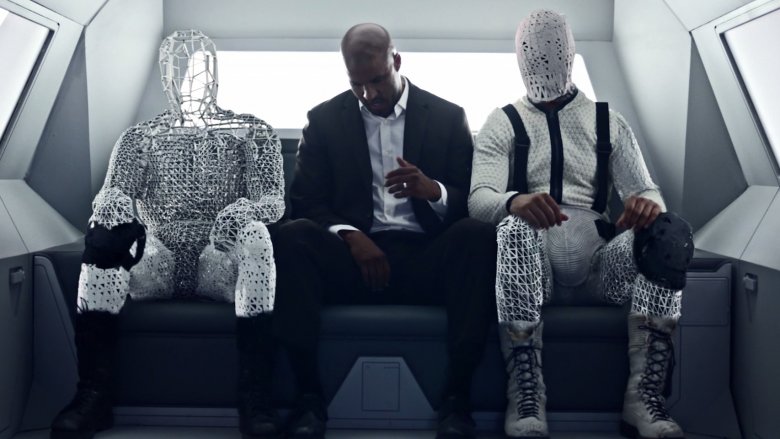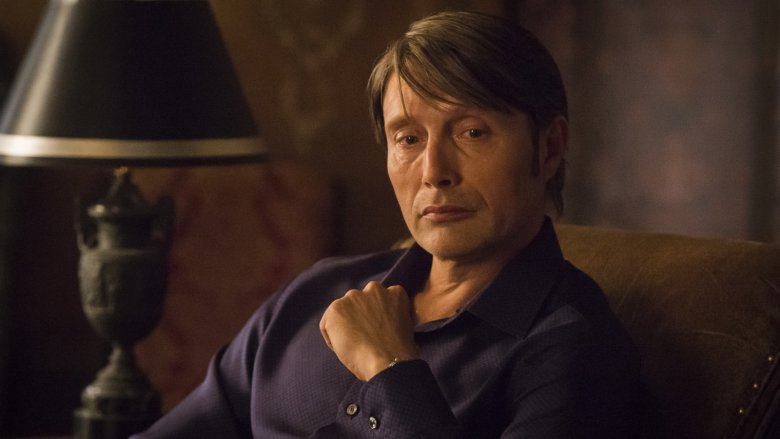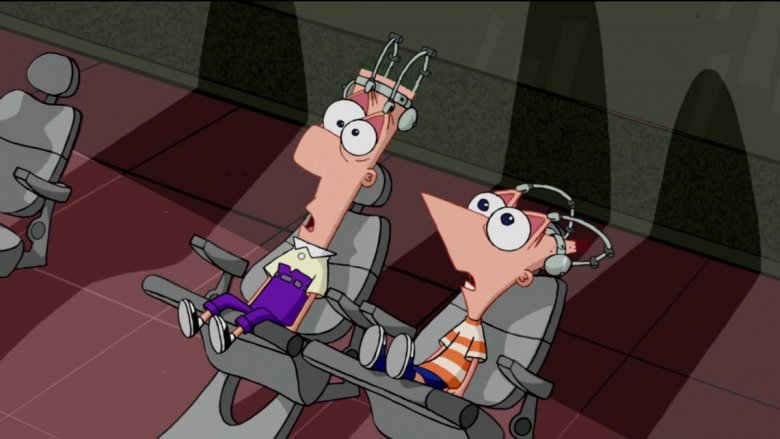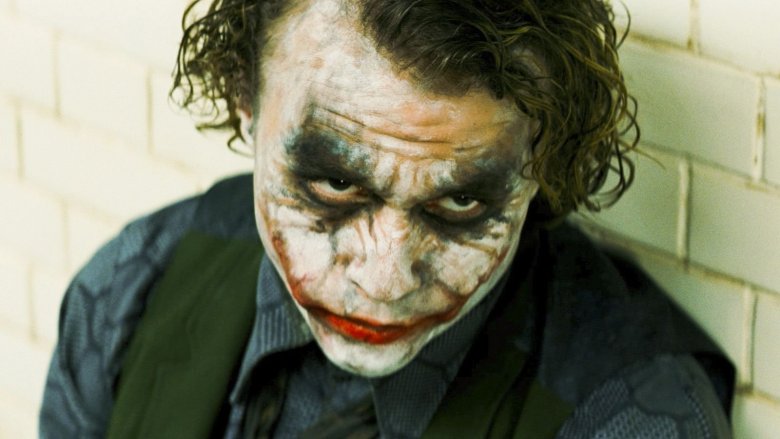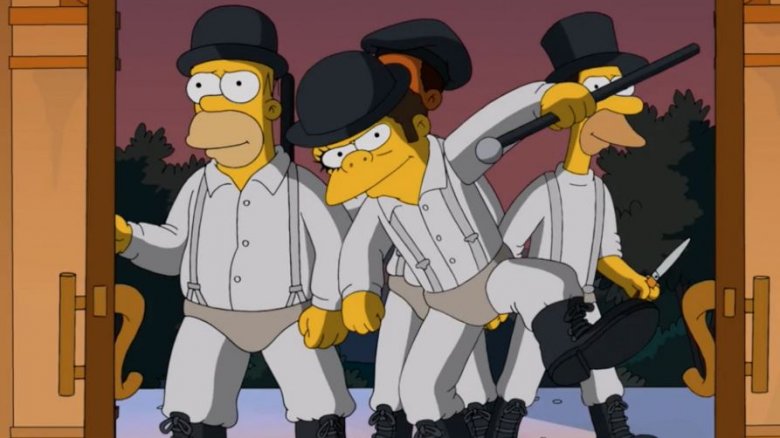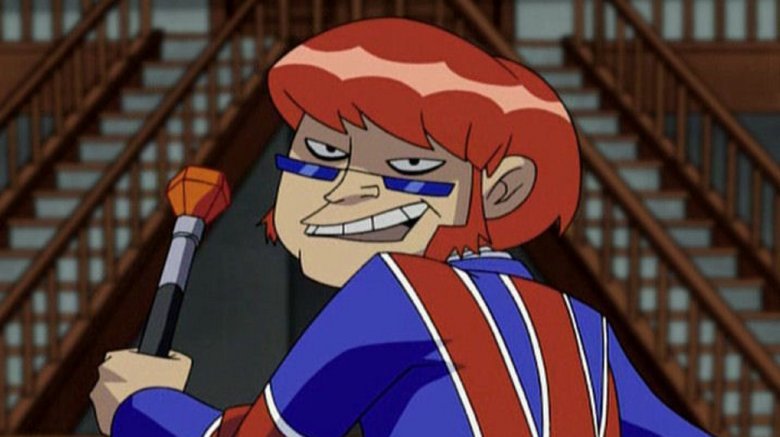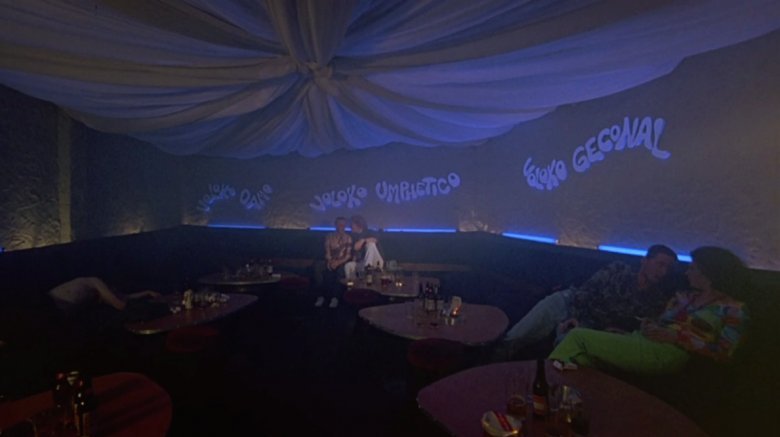A Clockwork Orange Easter Eggs Hiding In Other Movies And Shows
Based on the novel by Anthony Burgess, A Clockwork Orange is one of the best (and most controversial) movies of the 1970s. Despite the arguments surrounding the film's violence, this Stanley Kubrick picture has become an iconic piece of pop culture, mostly due to the sadistic main character, Alex DeLarge (Malcolm McDowell). And since the film came out in 1971, multiple directors and showrunners have referenced the Stanley Kubrick classic in their own works. So pour yourself a glass of milk as we delve into some of our favorite Clockwork Orange Easter eggs.
American Gods (2017)
The first episode of American Gods gave us all the great characters and bloody mayhem that we've come to expect from Bryan Fuller. One of the things that we really loved was the design of Technical Boy and his minions, the Children. If they looked oddly familiar, well, there's a reason for that. Bryan Fuller based the design of the Children off Alex's droogs from A Clockwork Orange.
Alex's droogs (which is an adaptation of the word "friend" in Russian) are well-known for their weird white jumpsuit/suspender combination, one of the best costumes that Stanley Kubrick ever put on camera. The Children use the same getup, just without the black hats. Of course, they make up for the lack of headgear with their creepy non-faces. And just like the droogs, the Children enjoy a bit of the old ultraviolence, beating the crap out of Shadow and even hanging the poor guy...on the day of his wife's funeral no less!
Fuller says that he's legally prohibited from using the "d-word" to describe the design of the Children, but we know the guy loves Stanley Kubrick, so it only makes sense that he added a Clockwork Easter egg for fans to find. And while Alex's henchmen are pretty scary, we've got to admit, those faceless thugs in American Gods are about as creepy as it gets.
Hannibal (2015)
One of the reasons A Clockwork Orange is so unnerving is thanks to the music. After all, Stanley Kubrick expertly used happy songs to score some horribly violent scenes. The most shocking example is, of course, the use of "Singing in the Rain" during the infamous rape sequence, but another great example is earlier in the movie when Alex beats up his droogs to the lighthearted sounds of Rossini's "The Thieving Magpie."
Fuller, being a huge Stanley Kubrick fan, hid a fun reference to that iconic fight scene in his grisly TV show Hannibal. In episode five of season three, former FBI investigator Jack Crawford catches up with Hannibal Lecter in Italy, where the crazed doctor has gotten a creepy job perfectly suited for him. As it turns out, he's running a museum dedicated to torture instruments. Of course, Jack isn't interested in touring the joint, as he only has one thing on his mind. He wants to get back at Hannibal for slicing him up during the season two finale.
The resulting fight is amazing, and sharp-eared fans picked up on the use of "The Thieving Magpie" as the soundtrack, which Fuller admits is a direct reference to A Clockwork Orange. Not content with just using the same music as Kubrick, Fuller also used similar editing techniques, slowing down key shots and speeding up others. The fight is wonderfully gory as Jack and Hannibal beat each other to a pulp with old-school torture equipment. In fact, it's ultraviolence worthy of Alex and his thugs.
Phineas and Ferb (2008)
For a children's show, Phineas and Ferb made a ton of pop culture references that are definitely not appropriate for children, including a first season episode where the two boys experience the same brainwashing techniques that Alex goes through in A Clockwork Orange.
The episode starts with the creative boys inventing a flying car and a giant tower for it to land on. Unfortunately, their engineering isn't up to par this time, and the tower collapses, wrecking half of their house in the process. Enraged, their sister Candace convinces their parents to send the boys to a reform school that brainwashes kids to make them less creative. Turns out, the folks running the reform school must've watched A Clockwork Orange because they use the Ludovico technique from the movie, pinning Phineas's and Ferb's eyes open and forcing them to watch the videos that will make them less creative. When the procedure doesn't work, the school then puts them into forced labor and solitary confinement.
True, torturous aversion therapy is a weird thing to have in a children's show, but fortunately, the boys are rescued before it can take hold. That's probably a good thing, as the long-term effects of brainwashing aren't really something that children need to deal with. But interestingly enough, this Clockwork Orange rabbit hole goes even deeper when you realize that the character of Reg (who doesn't appear in this particular episode) is played by none other than Alex DeLarge himself, Malcolm McDowell.
The Dark Knight (2008)
While Heath Ledger was playing the Joker in The Dark Knight, he kept a creepy journal of all of his influences and thoughts. And as you've probably guessed, the diary contained several references to A Clockwork Orange. That only makes sense as both Alex DeLarge and the Joker are sadistic psychopaths who just want to hurt, destroy, and watch the world burn.
But Heath Ledger wasn't just inspired by the 1971 film. Instead, it seems like he actually incorporated a visual Easter egg from the film, something a lot of people call the Kubrick Stare. At some point in nearly every single Kubrick movie, the director has one of the characters stare at the camera with their head tilted down, looking up from under the eyebrows, with a crazed look in their eyes. It's a visual signature to show the character is at the end of his rope, about to descend into insanity and violence.
While it shows up in most of his movies, one of the most iconic Kubrick Stares is featured in A Clockwork Orange. Malcolm McDowell pulls off the move perfectly, somehow appearing both menacing and disconnected with one single facial expression. Heath Ledger perfectly replicated it in The Dark Knight, throwing the Kubrick Stare around throughout the movie. Not only is it a nice way for Ledger to acknowledge his influences, it's also scary as all get-out.
Tenacious D in The Pick of Destiny (2006)
Starring Jack Black and Kyle Gass, Tenacious D in The Pick of Destiny contains one of the more obvious references to A Clockwork Orange. Early on in the film, Jack Black is down in the dumps and curls up on a park bench after singing a lonely ballad. However, he doesn't stay asleep for long, as he's woken up by a bunch of hooligans dressed like Alex's droogs. Naturally, the thugs taunt him a bit and beat the guy up before running off into the night. Really, it's a pretty random reference and a tad ham-fisted, but hey, this is a movie where Satan himself is the bad guy. In other words, if you were expecting a subtlety in a movie where Jack Black faces off with the devil, well, then you're watching the wrong movie.
Gangster No.1 (2000)
Gangster No.1 is an obscure 2000 British crime-drama that's worth watching if simply for the fact that it's basically one long Clockwork Orange Easter egg. The movie follows the life of a London gangster as he grows in prestige, and Malcolm McDowell plays the crook during the parts of the movie where we see him as an older man. Sure, having McDowell play a British gangster is a close enough reference to the Stanley Kubrick classic, but Gangster No. 1 almost seems like it might be an unofficial sequel to the original movie.
The younger version of the gangster (played by Paul Bettany) is constantly giving the Kubrick Stare. There's also a brutal beating scene set to pop music. And the way both McDowell and Bettany play the character is so much like Alex DeLarge that film critic Roger Ebert wrote, "If Alex DeLarge of A Clockwork Orange had become a London gangster, he might have turned out like the hero of Gangster No. 1."
Unfortunately for the filmmakers, barely anyone saw the movie, and all its clever nods are lost to cinematic history. Of course, maybe that's for the better. A key part of Alex's character was his youthfulness, and seeing an old version of the same character wouldn't be nearly as cool.
The Simpsons (2014, 2016)
Over the course of dozens of seasons and countless episodes, The Simpsons have included many references to A Clockwork Orange. One of our favorites is a subtle Easter egg in the season 27 episode "Much Apu About Something," where Bart convinces his family that he is going to stop pranking, only to fall back into his old habits. Bart marks his return to the dark side by applying Alex DeLarge makeup, but as Bart is only ten years old, we're pretty concerned about why Homer let him watch A Clockwork Orange.
Of course, the greatest reference to A Clockwork Orange comes in "Treehouse of Horror XXV," which features a parody called "A Clockwork Yellow." The segment follows Moe and his droogs as they attack an Eyes Wide Shut-style orgy, avoid getting shot by Private Pyle in a bathroom, and beat people up with bones a la the apes in 2001: A Space Odyssey. In other words, there are enough Easter eggs to hear to satisfy even the most die-hard Kubrick fans.
Fargo (1996)
In their 1996 crime classic Fargo, the Coen brothers included a Clockwork Orange Easter egg that happens so fast that it's super easy to miss. The quick little reference occurs as Carl Showalter (Steve Buscemi) and Gaear Grimsrud (Peter Stormare) are taking a trip through Minnesota and North Dakota. Along the way, the hired thugs pick up some prostitutes, and while Carl tries to put the moves on one of the girls, he says that he's, "Just in town on business. Just in and out. Just a little of the old in-and-out." Of course, the "old in-and-out" is the same euphemism that Alex DeLarge uses for sex. And you know, it only adds to Carl's creepiness that he's using pick-up lines from a fictional rapist. So here's a pro-tip for all you single guys out there: don't quote Alex DeLarge on a date.
Star Trek: The Next Generation (1991)
One of the most criminally underrated episodes of Star Trek: The Next Generation is fourth season episode "The Mind's Eye." It's a cool, suspenseful episode, with horror elements mixed in. Plus, it shows us the Romulans are fans of A Clockwork Orange, or at least have their own version of Stanley Kubrick.
In the episode, chief engineer Geordi La Forge gets captured by Romulans, and the aliens realize they can torture and brainwash him into killing a Klingon officer to destabilize Federation/Klingon relations. Of course, Geordi won't give in easily, so the Romulans use the Ludovico technique from A Clockwork Orange. Only, since Geordi is blind, they pipe images of violence straight into his brain. Now, he can't escape, as the horror is happening within his own mind.
Eventually Geordi gives in to Romulan control. But don't worry. Picard, of course, figures out a way to save his chief engineer, and Geordi goes back to normal, ready to fix the warp core in the next episode. However, The Next Generation made the Ludovico technique more horrifying than it was in A Clockwork Orange. Pinning open eyelids is a creepy visual, but having horribly violent images beamed directly into our minds sounds like a much worse fate.
Teen Titans (2003-2006)
A recurring villain in the DC universe, Mad Mod is an eccentric fashion designer who uses his style and technology to brainwash and wreak havoc. When the character was introduced into the original Teen Titans TV show back in 2003, Malcolm McDowell was cast in the part, and soon, the show went full-bore on A Clockwork Orange Easter eggs. For example, if you're going to cast McDowell as a guy who messes with people's minds, then you've got to have him use the Ludovico technique.
On his first introduction, Mad Mod straps the Teen Titans into chairs and forces them to watch mind control videos. Naturally, Mad Mod is defeated, but as he returns throughout the show, the artists gave the character a ton of weird psychedelic imagery that wouldn't look out of place in A Clockwork Orange. Clearly they wanted to place a few Easter eggs for the parents who would watch Teen Titans with their kids. And Malcolm McDowell always sounded like he had a blast playing the character. After all, Mad Mod is a grown-up Alex DeLarge who's big into fashion and revenge. What's not to love?
Trainspotting (1996)
One of Ewan McGregor's greatest films, Trainspotting is a masterpiece of British cinema, and it's also packed with several references to A Clockwork Orange. For example, there's the Volcano nightclub, and we're not just talking about all the uncomfortable sexual shenanigans. It seems safe to say that director Danny Boyle modeled the look of the joint after Clockwork's Korova Milk Bar, especially all that weird writing on the walls. But it's not just the look of the club that's an Easter egg. The background music is played by Heaven 17, a band that was named after a fictional pop group from the Anthony Burgess novel.
It's not surprising that Danny Boyle would sneak in references to the film since A Clockwork Orange was one of his pivotal movie-going experiences growing up. When the movie came out, he and a friend were able to sneak into the theater, even though they were only 15. The movie was pretty shocking for a teen in the '70s, but it was also inspirational...and not for any creepy reasons, thanks heavens. Young Danny Boyle was impressed by how many risks the movie took, and he wanted to do the same thing with his own work. With titles like Trainspotting, 28 Days Later, and 127 Hours in his filmography, we think he's done a pretty good job.
Hellraiser (1987)
Directed by horror icon Clive Barker, Hellraiser is a horror classic that gave the world Pinhead, one of the all-time great movie monsters. The film also contains a Clockwork Orange reference that's so quick that it's easy to miss. As it turns out, the Cotton House is located on 55 Ludovico Place, which is obviously a reference to the infamous torture technique that Alex experiences in Kubrick's masterpiece. Really, it's a nice little Easter egg, especially considering how the Cenobites would feel right at home working for the Minister of the Interior.
Robot Chicken (2005-Current day)
Robot Chicken makes a pretty obvious reference to A Clockwork Orange in its opening sequence, where the mad doctor straps his bionic creation to a chair and forces the poor bird to watch a bank of TV screens that show Robot Chicken sketches.
Since the implication is the audience is suffering alongside the chicken, we don't think it's that bad of a torture device, especially when we get to watch the Star Wars sketches. Hopefully that chicken never escapes, because who knows what crazy ideas it has after a dozen years of being force to watch Robot Chicken episodes. It's probably a pop culture genius.
However, creator Seth Green didn't let the Stanley Kubrick allusions stop there, going so far as to voice a stop-motion version of the famous auteur in a season three episode. Hey, if you can't actually be in a Stanley Kubrick movie, the next best thing is to pretend to be the man himself.
